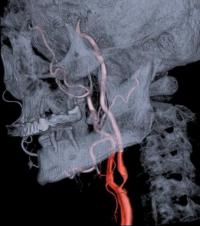What is the stenosis of carotid arteries?
Carotid artery stenosis is the narrowing of the carotid arteries which supply the brain with blood. It is most frequently the result of atherosclerosis and typically occurs at the fork where the common carotid artery divides into the internal and external carotid arteries. The narrowing of the inner surface of the artery caused by atherosclerotic plaque produces small blood clots and emboli. If clots or emboli travel further into the brain, they can block one of the smaller arteries and thus cause insufficient blood supply to brain tissue (ischemia).

What are the symptoms of brain ischemia?
Depending on the scale and location of the blocked blood flow, symptoms may vary greatly in both severity and their duration. Some strokes may last only a very short time and symptoms go away in a matter of seconds – these include momentary loss of vision in one eye, speech impairment, tingling sensation around the mouth and tongue, short term weakness of limbs on one side of the body or drooping of one side of the mouth.
When brain damage is permanent, symptoms are more profound and their repairment slow and imperfect, we speak of an ischemic stroke.
Should carotid artery stenosis be treated?
Large randomized trials have proved that a surgical procedure of carotid stenosis, i.e. carotid endarterectomy, can significantly decrease the risk of a stroke in selected patients. Patients with symptomatic carotid stenosis (those who have suffered stroke in the previous 6 months) are recommended to undergo carotid endarterectomy if stenosis exceeds 50%. In patients with 50-70% stenosis, surgery decreases the 5-year risk of another stroke by 4,6%. For patients with 70-99% stenosis, the surgery reduces the 5-year risk by 16 percent. Asymptomatic patients in whom carotid stenosis was discovered coincidentally during an examination (e.g. ultrasound examination) are recommended to undergo surgery if they have over 60 % stenosis.
Will the surgery improve my neurological condition?
It most probably will not - the surgery serves as a precaution against a stroke in both asymptomatic patients and those who have already suffered a stroke.
Which examinations are necessary?
Apart from routine pre-operative examinations which must precede every surgery, it is necessary to perform a detailed examination of arteries supplying the brain. There are several possible tests such as ultrasound examination (sonography), the imaging of arteries with CT angiography, magnetic resonance (MR angiography) or conventional angiography (digital subtraction angiography - DSA). All necessary examinations are performed during patients’ hospitalization in our department. Patients are informed about procedures and the choice of examinations in detail by their attending physician.
How does the surgery proceed?
Patients are visited by their anesthesiologist and surgeon who explain all details and answer all questions the day before the surgery. Patients are prepared for surgery the night before and are not allowed to drink or eat after midnight. Smokers are recommended to stop smoking at least two weeks prior the surgery. The surgery is performed in general anesthesia. The surgeon exposes the carotid artery at the fork area and makes a longitudinal incision 6-8 cm long to open it. Atherosclerotic plaque is then removed and the artery sutured with a continuous stitch using a very thin thread. A patient is then taken to post-operative unit and is allowed to get up and walk the next day and can be discharged 3 to 5 days after the surgery depending on his/her condition.
Which risks are associated with the surgery?
Paradoxically, the most serious danger of carotid endarterectomy is precisely what the surgery attempts to prevent: poor blood supply to the brain – a stroke. Although the risk is not insignificant, still, it is more favourable for patients to undergo the surgery. Other risks include infections, irregular blood pressure or local complications of the wound. A renowned American medical association AHA (American Heart Association) recommends that the surgery should be performed when the risk of complications is below 6 percent. Our deparment has a long-term complications rate below 3 percent.
Are there alternative options?
Yes, there is another possibility - endovascular treatment. A metallic stent (a small tube) is inserted through a femural artery into the afflicted area where it unblocks the narrowing. This procedure is quick and relatively uninvasive but it is not as effective as a surgical solution. The surgical procedure remains the best option while stent is indicated for patients who face an increased risk of complications (e.g. due to serious internal diseases, neck surgeries, neck irradiation etc.).
Will I need to come for follow-up visits?
Certainly! All patients will be followed after the surgery due to several reasons – stenosis can occur also in the carotid artery on the other side or the operation site could narrow because of scarring (the so-called myointimal hyperplasia). To discover this in time we perform regular ultrasound follow-ups – at first more often (every 3 to 6 months) and later once a year.
Are there any restrictions after the surgery?
No. However, it is important to realize that atherosclerosis does not affect only the carotid arteries but all blood vessels in the body and thus the same problem may occur in the arteries of heart, kidneys or lower extremities. That is why all patients should adjust their lifestyle to minimize other possible risks. A patient’s attending physician should regularly check the level of bloodfat and prescribe medicine to decrease it, if necessary. Smoking is the leading factor in the progression of atherosclerosis. All smokers are recommended to quit smoking to prevent possible risks.
